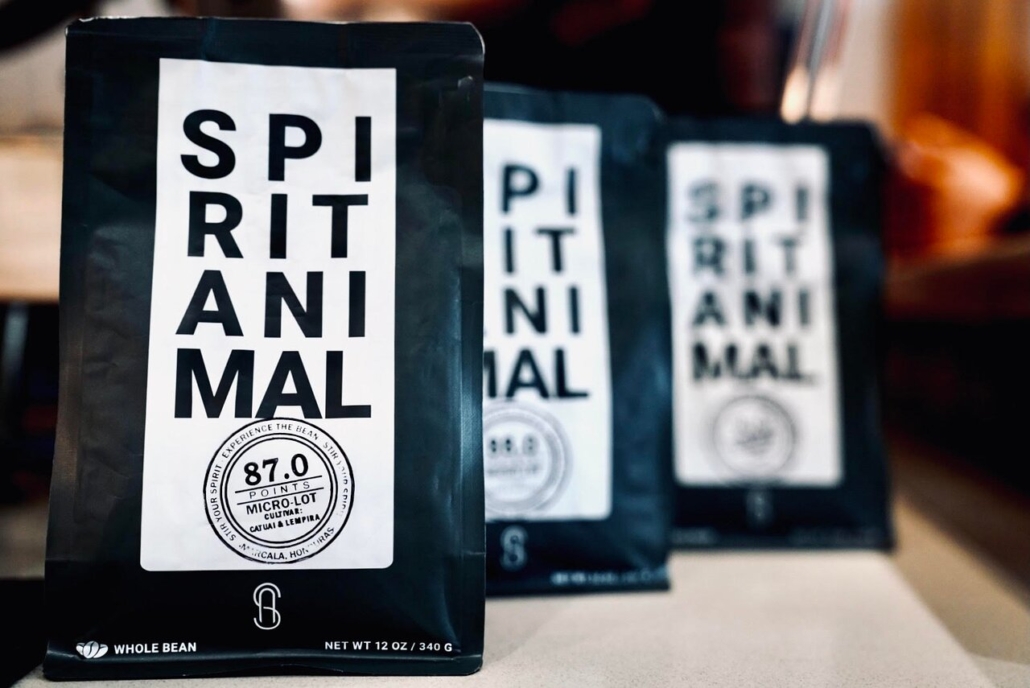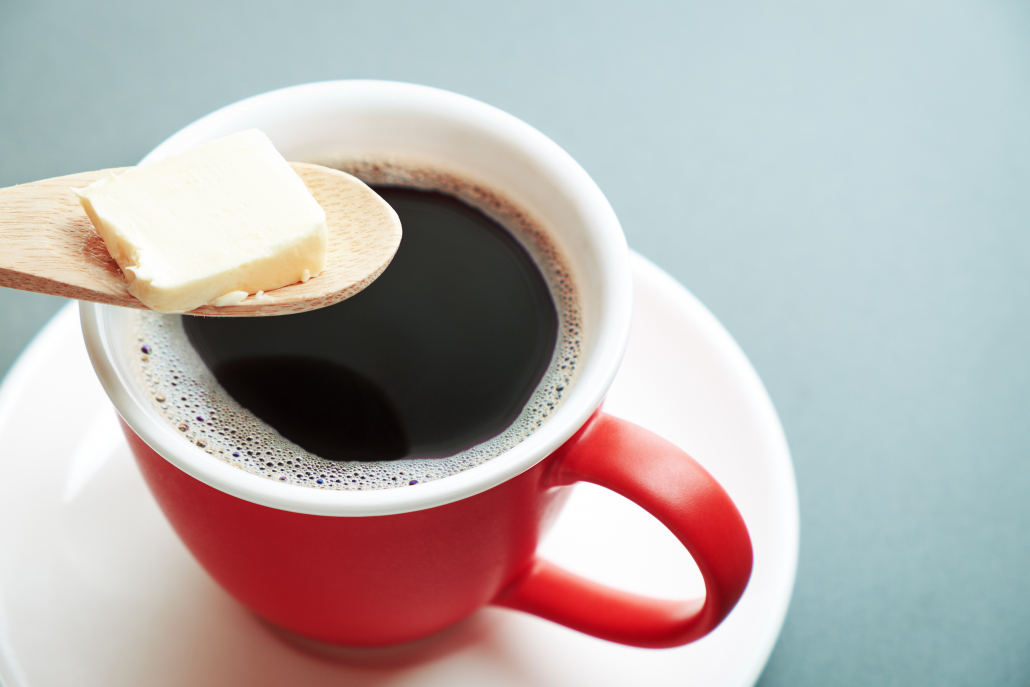We include products in articles we think are useful for our readers. If you buy products or services through links on our website, we may earn a small commission.
Mold in Coffee and Coffee Makers: Risks and Solutions
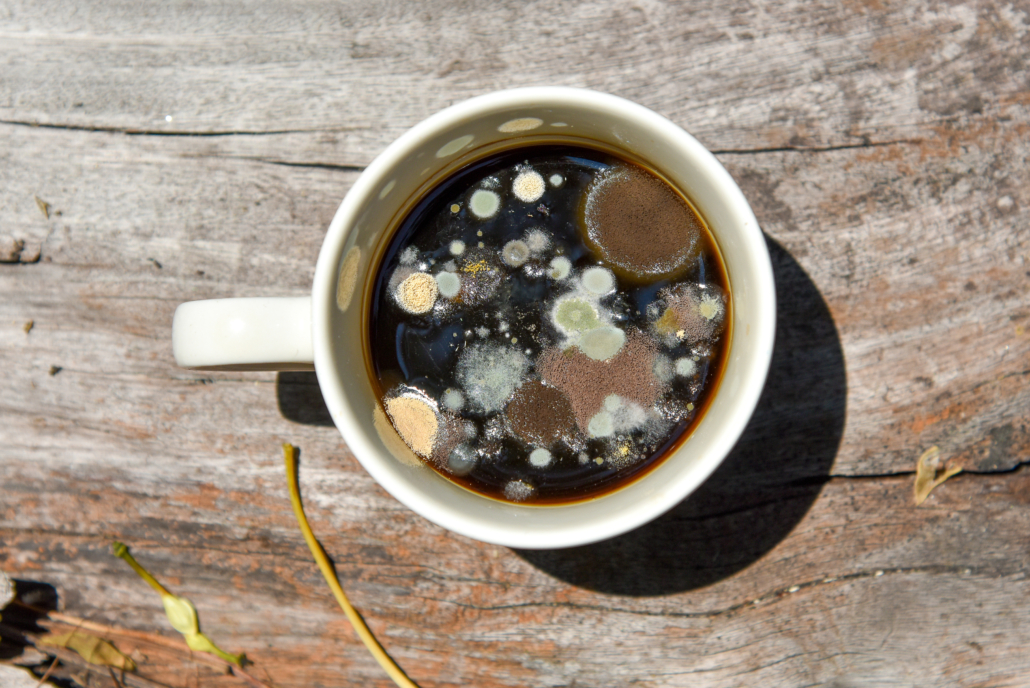
Did you know that researchers have routinely found mold in coffee and coffee makers?
And did you know that repeated exposure to even small doses of these toxic coffee molds (mycotoxins) can cause serious health issues?
In this article, we’ll explore what causes mold in coffee and coffee makers and how they can affect your health. We’ll also offer tips for choosing mold-free coffee and for getting rid of the mold in your coffee maker.
Table of Contents
Fast Facts About Mold in Coffee
Research on the presence and effects of mold in coffee is still emerging. Here’s a rundown of what we know so far.
- The toxic products of mold on coffee are called mycotoxins
- Mycotoxins have been found in various concentrations in significant proportions of coffee from various countries
- Green and decaf tend to have higher levels
- Decaf coffee has more mycotoxins because caffeine inhibits the growth of mold
- Studies have found that 33% of green coffee beans from Brazil had low levels of ochratoxin A
- A 1996 study found that 45% of commercially available coffee beans contained Ochratoxin A
- A study on Portuguese coffee found that 18% of commercial coffee beans contained ochratoxin A
- A 2013 study found that 27% of all roast coffees tested contained ochratoxin A. Beans from Chile had the highest concentrations
- A 2021 study found that there is no evidence that ochratoxin A in coffee is acutely toxic in small doses–but this study did not look at repeated exposure over time
- A study in Spain found that drinking contaminated coffee exposed people to only 3% of the maximum allowable ochratoxin A levels
- A study from 1996 found that if you drink four cups of coffee a day you will only be exposed to 2% of allowable ochratoxin A levels
- Responsible coffee growers know about mycotoxins and have effective ways of reducing and eliminating them
- “Wet processing” gets rid of most mycotoxins
- Roasting has been shown to reduce ochratoxin A by 69-96%
What Mold is in Coffee?
Researchers have found that significant percentages of global coffee beans are contaminated with toxic compounds called mycotoxins.
Mycotoxins are the toxic products of molds in coffee beans that have been processed and stored improperly–usually in damp environments.
There are over 16 types of mold found in coffee, and two that are more prevalent and widely studied than others:
- aflatoxin B1
- ochratoxin A
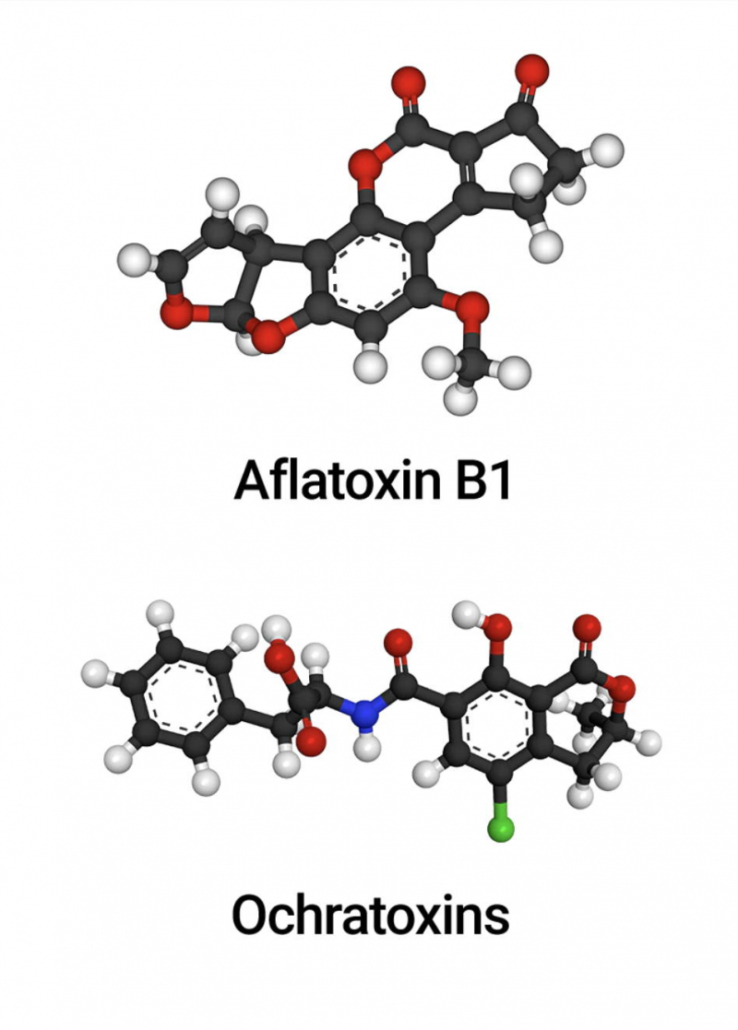
Aflatoxin B1 is a carcinogen, meaning that it is known to cause cancer in addition to other serious health issues.
Ochratoxin A is less studied and thought to have weaker carcinogenic properties. It may also damage the kidneys.
The images below show what toxic mold in coffee looks like.
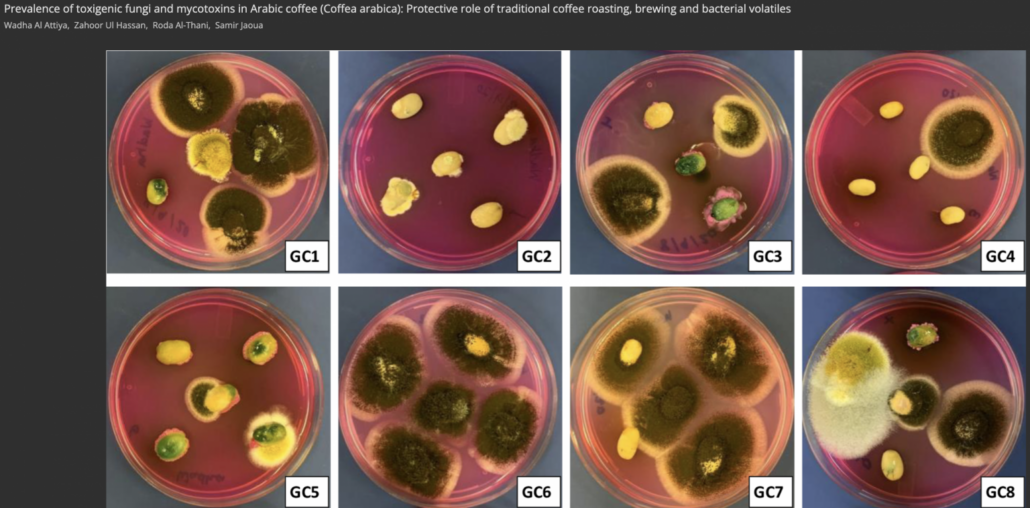
These graphs demonstrate how roasting and brewing can reduce mycotoxins in coffee.
According to the World Health Organization, exposure to the types of mycotoxins produced by mold in coffee can lead to long-term health issues, including
- Immune deficiency
- Severe allergies
- nausea
- dizziness
- gastro-intestinal problems
- In serious cases, cancer
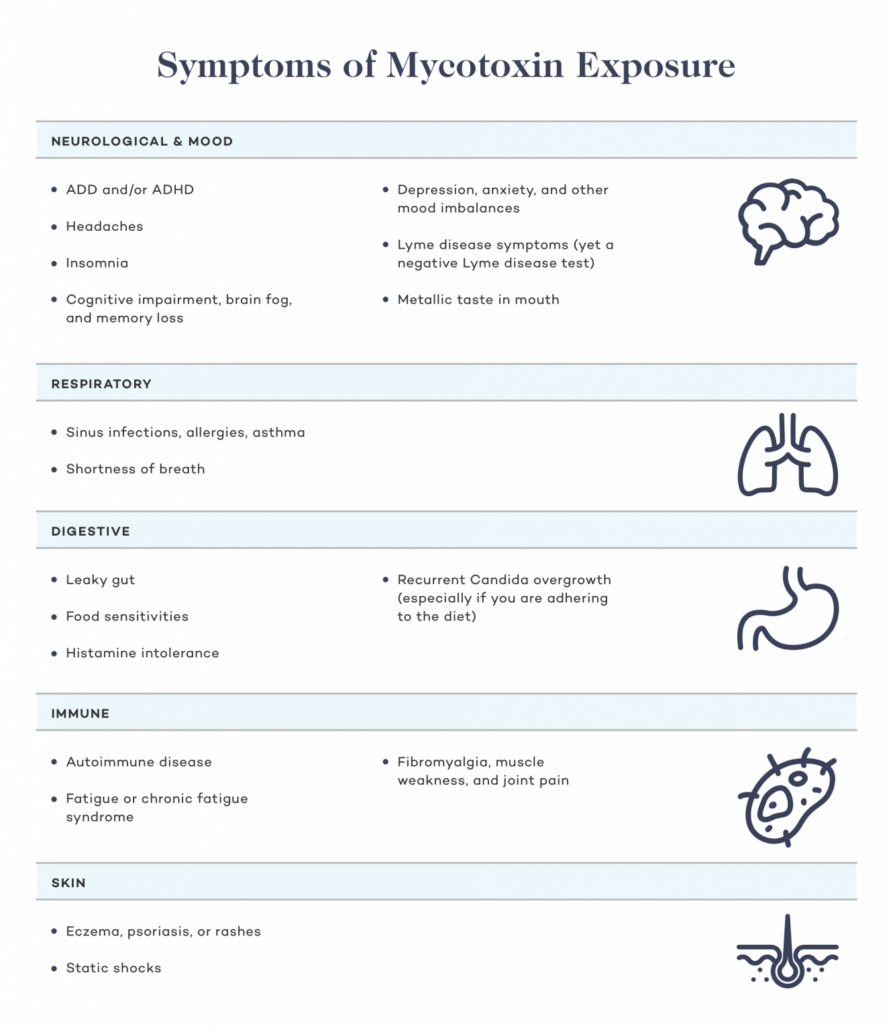
Though studies suggest that drinking coffee exposes people to only small percentages of safe allowable limits, long-term low-dose exposure may cause insidious health issues.
The good news is that there are a few rules of thumb you can follow to protect yourself.
What Causes Mold in Coffee?
Several factors contribute to moldy coffee:
- Climate: Mold grows well in moist, tropical environments. Most coffee is grown in tropical latitudes around the globe
- Soil conditions: In some areas, the mold that makes its way to the bean already exists in the soil or surrounding plants
- Processing practices: Wets processing without proper drying promotes mold growth. Dry processing–leaving on the moist outer layers– means the beans are intrinsically damp for longer
- Storage: Beans that sit longer in storage areas that are not carefully climate-controlled are more susceptible to mold
Tips for Avoiding Mold (Mycotoxins) in Coffee
Despite the prevalence of mold in coffee, these tips will go a long way in ensuring that your cup of Joe is mold-free
1. Choose High-Altitude Coffee Beans
High-altitude coffee beans are grown in cooler and dryer environments than low-land varieties. This makes them far less likely to contain toxic molds. They’re also lower in pesticides since there higher altitudes tend to have fewer pests.
2. Select Wet-Processed Beans
Beans that have been wet-processed and sun-dried have fewer mycotoxins than standard industrial processes.
3. Go With Certified Toxin Free Coffee
The reality in the coffee industry is that most companies know about mycotoxins in coffee, but few actually test for it. And even if they say they do, and that they’re “mold-free,” they generally don’t release the data.
That’s why certified mold and toxin-free coffee are the only truly safe ways to avoid exposure to coffee mold.
Certified Clean Coffee Companies
The more reliable and transparent of the so-called “clean coffee companies” is Spirit Animal Coffee.
They provide certification from a third-party lab that tests for sixteen possible mycotoxins.
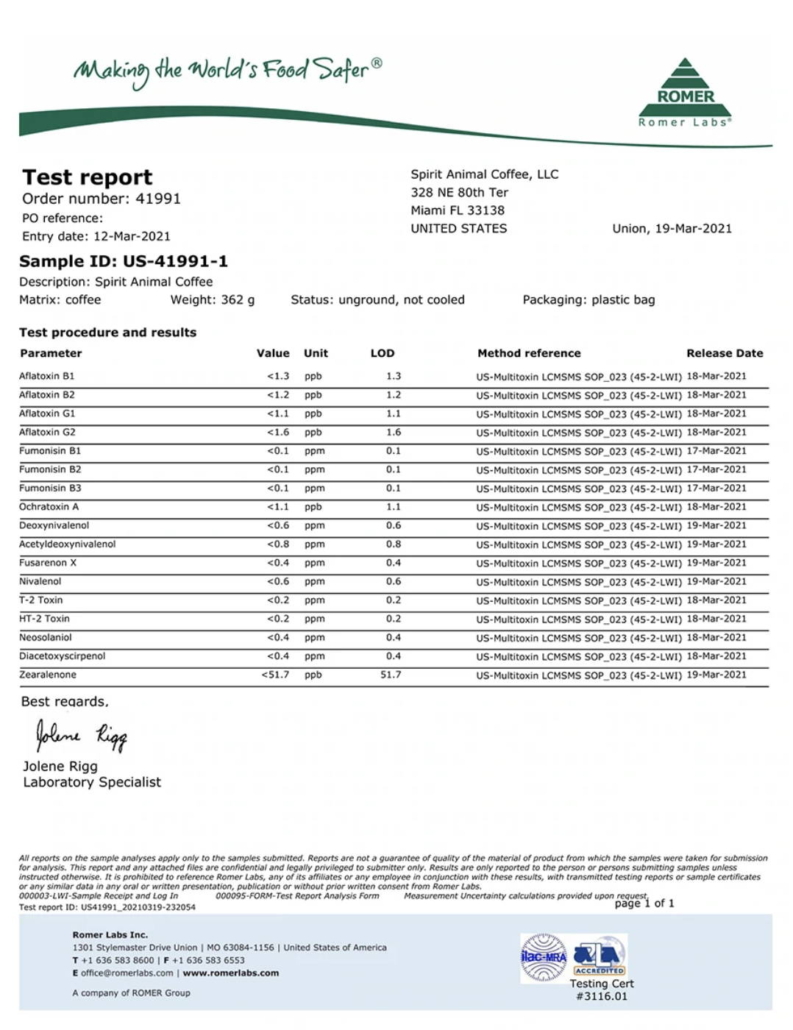
Natural Force Clean Coffee is another company that practices industry-leading standards.
Brands like Bulletproof Original Coffee and Peak Performance are the next tier when it comes to trust. These brands were built on being mold-free promises, but they don’t share the testing results.
Mold In Coffee Maker and Water Reservoir
If you’re concerned about mold in your coffee, the beans aren’t the only place to look.
A 2011 study found that nearly 50% of coffee makers (basket-and-carafe type) had yeast and mold in their reservoirs. With 1 out of 10 breeding coliform bacteria.
To put this in perspective, the average home coffee reservoir contains more potentially harmful germs than toilet seats and bathroom door handles.
Fortunately, there are a few easy steps you can take to clean the mold out of your coffee maker and water reservoir. These steps also provide the added benefit of making better-tasting coffee.
- Fill the coffee maker’s water reservoir with equal parts white vinegar and water. Set to brew through a paper filter until half of the vinegar/water solution is drained.
- Turn it off and let sit for 30 minutes. Then turn on again and let the maker finish brewing the other half of the solution.
- Rinse by brewing a full reservoir of plain water through a paper filter. Repeat this step twice.
- Gently clean the carafe by filling it with warm, soapy water–you can add a handful of rice as a gentle abrasive: swirl and scrub.
And there you go–an easy routine for germ-free coffee pleasure.
Mold in Coffee and Coffee Makers: The Bottom Line
Coffee beans and at-home coffee makers are often contaminated with toxins formed from mold.
Though low levels of exposure to mold in coffee and coffee makers aren’t immediately harmful to most people, there has not been any research looking at repeated exposure over time.
Since mycotoxins can be remarkably harmful in even small doses, it is wise to choose certified mold-free coffee and to clean your at-home coffee maker and reservoir regularly.
It’s also important to store your coffee in a cool and try place.











